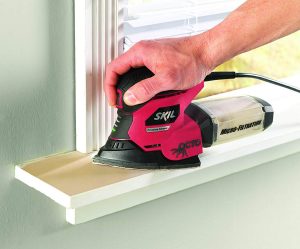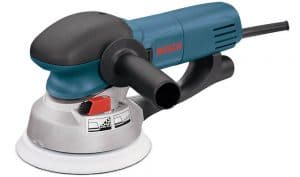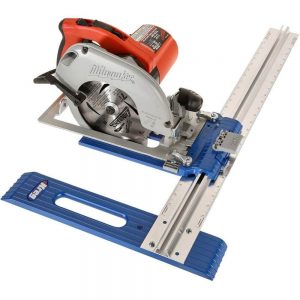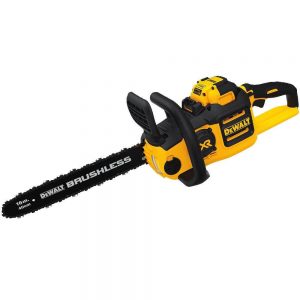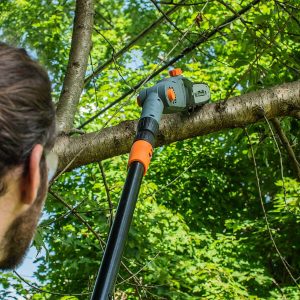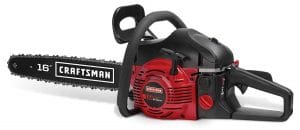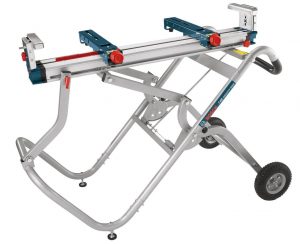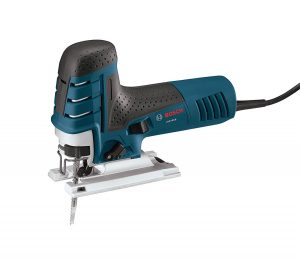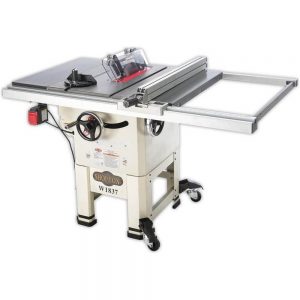Home Improvement » Saws » The Best Circular Saws in 2023
The Best Circular Saws
A circular saw is every carpenter’s best friend. They’re a workhorse tool, used dozens of times a day in the field and probably needed to do the same for any home projects you’re getting involved in. But how do you, the enlightened home handyman, make sure that you have the right saw for your needs?
Well, that’s what we decided to figure out. We gave some of the top selling models a test so that we could make sure that you’ve got the right choice for your home or work truck. So, let’s get this nice and flush cut for ya with some of the best around and how we selected them to make sure you don’t have a lemon.
In This Article:
The 6 Top-Rated Circular Saws
| Editor’s Picks | Brand | |
|---|---|---|
| Best Overall Circular Saw | Makita 5007MG | |
| Runner Up for the Best Circular Saw | DeWalt DWE575SB | |
| Best Cordless Circular Saw | DeWalt DCS391B 20-Volt MAX | |
| Best Wormdrive Circular Saw | SKILSAW SPT77WML-01 | |
| Budget Pick | SKIL 5280-01 | |
| Bonus Round: Best Compact Circular Saw | Rockwell RK3440K Versacut |
Who Needs a Circular Saw?
We’d argue… anyone who occasionally needs to cut wood. Indeed, if you were only going to have one saw in your arsenal it should be a circular.

Therein lies the big advantage of circular saws: they’re extremely powerful but you can carry one around the garage or jobsite relatively easily. Most people can learn to operate one efficiently with a couple of passes.
There’s a reason they’re a mainstay in basically every garage, toolbox, and shop around the world: they’re versatile, convenient, and powerful.
How We Selected Our Circular Saws
We made the usual rounds before diving into selection, asking a variety of handymen and carpenters what they were looking for in their circular saws to get the most out of them.
For an amateur? Safety features.
We’ll be realistic here, the truth is that most amateurs aren’t all that great with their saws in the first place. We tend to agree with them.
Necessary Safety Features
If your saw doesn’t have these… pass on it. Replace it. A circular saw is no joke, an injury with one even to an extremity can be fatal due to rapid blood loss. They’re meant to tear apart hardwoods, your muscle and veins really don’t stand a chance.
So, make sure any saw you consider has the following:
- Retracting blade guard
- A solid foot plate
- Trigger safety
The trigger safety was the only one we found lacking on some.
Missing blade guards seems to be a fairly constant problem when it comes to second-hand purchases, so if you go down that route make sure that the guard still works smoothly and easily before handing over your cash.
Power
This is where things get a bit iffy. Many of us are used to looking at power in tools by either checking out the amperage or the horsepower rating of the motor.
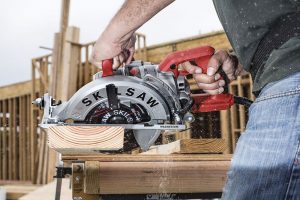
In an ideal world these would be easy to read statistics, but in practice we found that there were variances even in circular saws with the exact same technical specifications.
Cordless Saws
Cordless saws are great for those who only need light use out of their saw. Unfortunately, they also tend to be underpowered.
It’s the usual trade-off here: power vs. convenience.
We’d note that cordless saws do go through power surprisingly quickly for a saw which is usually only in use for a short amount of time due to the power required to spin the blade through the material.
Drive Type
There are a few different drive types. The usual “sidewinder” motor is still a robust piece of engineering. Even the smaller models do a great job in the field for light usage.
They operate by bringing the motor directly alongside the blade and spinning it… well, like you’d imagine that a motor would.
On the other hand, wormdrive motors were all the professionals would talk about. They’re heavier, but they also produce far more power with the same amperage because of the increased torque. These motors are perpendicular to the saw blade, using a series of gears to increase torque and deliverable power to the blade.
Weight
We noticed quickly that these saws varied quite a bit in weight. Some were much lighter than others in the end, which made them easier to use for a long day.
Unfortunately, we also found weight to be almost directly tied to the power of the saw itself. Heavier saws are more powerful for the most part and the minor weight differences often mean inferior materials used in the parts.
Overall Build
When it boiled down to it, there were some little variations in saws. Hooks, lasers, wider bevel angles. All of these meant little when compared to our biggest performance indicator: the overall build of the saw.
Build-quality is always important, but usually we end up surprised by one or two budget products. In this case, basically… the better the saw looked and felt in our hands the better it performed. Little else seemed to matter.
Author:
Popular Articles:
The Top Circular Saws in 2021
After testing the cutting, ripping, and safety capacity of a few dozen circular saws, we’ve brought you the best of the best. Take a look and let’s see if we can’t help you get exactly what you need for your next project.
Best Overall Circular Saw
 Makita 5007MG
Makita 5007MG
The Makita 5007MG at a Glance:
- Amperage Rating: 15.0A
- Max RPM: 5800
- Weight: 10.6lbs
- Blade Size: 7 ½”
- Motor Configuration: Sidewinder
Of all of the circular saws that we put through the paces, the Makita 5007MG proved to be a fast favorite. It’s lightweight, powerful, and just feels solid in the hand.
The magnesium frame is what put this one at the top of our list. The strong but lightweight metal allowed for a more powerful motor than the majority of the saws we checked out while also allowing for the frame to stay lightweight.
The only real drawback?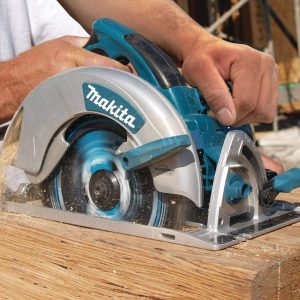
In action? Smooth, powerful, and intuitive. Needless to say, we were quite fond of this saw but those who don’t have need for a super powerful saw may end up with a bit of sticker shock.
Our Opinion:
This was our favorite of the saws we tested by a long shot. It’s lightweight magnesium frame was undoubtedly our favorite feature, but the overall solid quality shows in every bit of the saw. Especially once it’s in action.
- Very powerful
- Lightweight and portable
- High build-quality
- Great ergonomics
- A bit expensive for minor tasks around the home
- Could have a bit more torque
Runner Up for the Best Circular Saw
 DeWalt DWE575SB
DeWalt DWE575SB
The DeWalt DWE575SB at a Glance:
- Amperage Rating: 15.0A
- Max RPM: 5200
- Weight: 8.8lbs
- Blade Size: 7 ½”
- Motor Configuration: Sidewinder
When it comes down to it, DeWalt is always hard to beat out. This lightweight 7 ½” saw came close but in the end the Makita just outperformed it for marginally more weight. Also, while the ergonomics on the DeWalt DWE575SB aren’t bad, the Makita ended up being easier to use for extended periods.
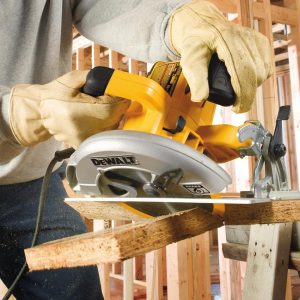
We did hear some rumblings from people about blade wobble but didn’t experience it in action. Sometimes it can be hard to gauge how well a tool performs when you hear complaints, but in this case we have to assume the few reports we got came from bad quality control rather than being a failing of the saw itself.
It also costs a bit more than the Makita, or at least it did when we purchased ours for the initial testing process. That was a strike against it as well
Our Opinion:
In the end, however, the DeWalt DWE575SB is a fantastic circular saw. Lightweight, powerful, and smooth. It’s only our runner up because of a slightly higher price tag and a bit less power.
- Great build quality
- Lightweight and maneuverable
- Powerful
- Excellent guard configuration
- Expensive
- Rumors of quality control problems
Best Cordless Circular Saw
 DeWalt DCS391B 20-Volt MAX
DeWalt DCS391B 20-Volt MAX
The DCS391B at a Glance:
- Amperage Rating: Battery Dependent
- Max RPM: 5250
- Weight: 7.0lbs
- Blade Size: 6 ½”
- Motor Configuration: Sidewinder
We tested four different cordless models. The truth is there’s no really “cheap” model out there which we would recommend to anyone who needs to get serious work done. For light duty saws you should check out our bonus review at the bottom.
We used the standard 20V 2.0A batteries with the saw. You really can’t compare a cordless side-by-side with corded saws. Bearing that in mind, it’s a powerful little saw and most people would be able to use it for at least a few cuts.
The biggest problem lies in its convenience: battery-operated saws are always a bit underpowered in the end. Still, we absolutely loved this saw and can confidently recommend it for those who rarely need one on the job or who just need to rip a couple of 2x4s around the house on occasion.
Our Opinion:
As a cordless? It’s on the edge of flawless. Just be aware of the limitations of a battery power source before you decide that it’s the perfect model for what you need.
- Lightweight
- Convenient
- Compatible with DeWalt MAX batteries
- Powerful for a cordless circular saw
- Expensive
- Can feel a bit underpowered
Best Wormdrive Circular Saw
SKILSAW SPT77WML-01
The SPT77WML-01 at a Glance:
- Amperage Rating: 15.0A
- Max RPM: 5300
- Weight: 11.6lbs
- Blade Size: 7 ¼”
- Motor Configuration: Wormdrive
We’ll be upfront: it’s really not fair to compare the cutting power of a good wormdrive saw like the SKILSAW SPT77WML-01. Of those we tested, this was the one we’d most recommend. It’s the best balance of cost and function around when it comes to worm drive saws, but if you need ridiculous power you may want to dig in your heels and drop the $300-$400 because you’re not going to beat this one under that.

The magnesium construction is a nice touch, keeping the steel to a minimum also keeps weight down. This one ended up being only a pound heavier than our favorite despite it being a larger saw overall.
The downside? Pricing. Worm drives cost a lot more to manufacture and you, as the end consumer, will end up paying the difference out of pocket. That’s life, you know?
Our Opinion:
If you’re looking for a serious job site saw, or just can’t see your workshop complete without having a worm drive, then we recommend you take a closer look at this powerful model. It’s smooth, powerful, and was among our favorites despite the relatively high cost.
- More torque than any sidewinder
- Incredibly powerful
- Smooth
- Lightweight for the drive type
- Expensive
- May be too much saw for home use
Budget Pick
 SKIL 5280-01
SKIL 5280-01
The SKIL 5280-01 at a Glance:
- Amperage Rating: 14.0A
- Max RPM: 5300
- Weight: 6.95lbs
- Blade Size: 7 ¼”
- Motor Configuration: Sidewinder
We tried out a number of cheaper saws and most of them were wanting. In the end, the SKIL 5280-01 was the only one that we could confidently recommend. It’s job site tough, while remaining the lightest saw on our list.
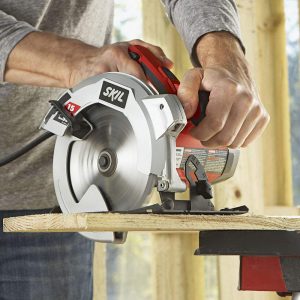
As you can see, it’s a full ampere underneath the other saws which topped our list. That means less power overall and as a sidewinder the lower power isn’t really compensated for. It’s still more than enough for most home DIY tasks however.
Our Opinion:
If you’re on a tight budget and looking for a great saw in a pinch, this is your new best friend. However, those who have the money to spend, may be better served with more powerful and solid circular saws.
- Ultra-lightweight
- Powerful for its size
- Good build quality
- Great price
- A bit underpowered
- Not quite as well built as our other favorites
Bonus Round: Best Compact Circular Saw
Rockwell RK3440K Versacut
While not strictly a circular saw, the Rockwell RK3440K Versacut definitely caught our attention. It’s a small device, shaped something like an electric multi-tool, and is one of the best saws we’ve seen for light duty tasks like cutting thinner MDF and or hardwood flooring.
That said if you’re ripping 2x4s this isn’t what you’re looking for. Instead, it’s best to think of the 4” blade as a handy way to cut through tough but thin materials.
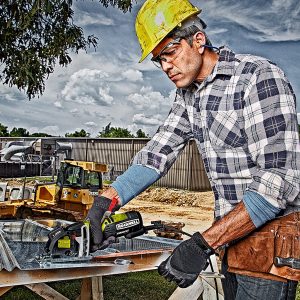
The use may be different here, but the principle is the same. Again, it’s not really fair to compare the cutting power between this and say the Makita 5007MG, but it held its own in testing once we found it’s proper niche.
Indeed, it’s a solid addition to the home of any DIYer, especially if you already have a table saw in the workshop for the tough stuff. The extra agility also makes it a good choice for many, it just has some limitations not normally present in a table saw.
Our Opinion:
While it’s a bit different, we really liked this niche usage compact circular saw. It’s an excellent supplement to the garage, but it’s not going to replace one of the big boys.
- Extremely easy to use
- Powerful enough for most materials
- Superior ergonomics
- Lightweight and agile in use
- Not quite a “real” circular saw
- Very limited cutting depth
Let’s Talk Blades
Circular saws are versatile, but like most of the powerful saws out there it’s essential to put some choice into the correct blade selection. Better blades can outlast lesser ones pretty easily.
If you’re not too concerned about it, a reputable blade in the same brand as your saw is your best bet. Just make sure the listed uses includes what you’ll be using the saw for, otherwise you might find yourself in trouble. You’ll also need to match the arbor size to the saw you’re using otherwise you just bought an expensive ninja-star.
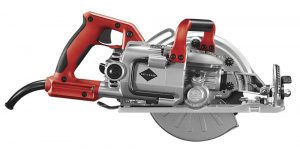
For those who are looking to make sure they have the optimal blade, you’ll need to make sure you take the following into account:
- Material-Common in the past, tool steel blades without any modification are rare these days. Even budget blades will be carbide tipped, increasing their longevity and maintaining the edge for longer than steel which lacks this modification. Be wary of any “special” blades unless they’re specific for your purpose or you know they come from a reputable brand.
- TPI-Teeth per inch, gives you a good indicator of how fine your cutting will be. Higher TPI? Smoother cut. On the same note, however, blades with a higher TPI will also cut slower. Match this to your purpose, roughly 25 TPI is standard for framing work while smooth cuts in long sheets of plywood may need 100 TPI or more.
- Size-The manual with your saw should let you know if you can run any size of blade other than the one which came in it. Many saws can accept smaller blades but you won’t be able to go any bigger due to the guard’s construction.
- Intended Use-Take this into account, especially if you’re not familiar with the blade you’re buying. They exist for everything from rough cutting 2x4s to relatively fine work in thin plastic paneling. Blade design is a fine art, trust the manufacturer.
All of the saws that made our list came with their own blades that we used during testing. Many professionals prefer to switch to high-end blades as soon as they get a saw but an amateur will generally be fine with the “general-use” blades that come packaged with the saw until they dull.
Safety Considerations With Circular Saws
Circular saws are infamous for doing extensive damage when they’re mishandled.
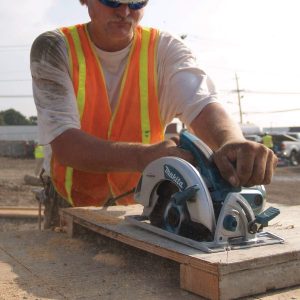
Unless you’re extremely lucky, the amputation of a few fingers is a best case-scenario end to a circular saw accident. Fortunately, it’s remarkably easy to not harm yourself with one.
The other big thing is to always set the depth of cut appropriately for the workpiece. Roughly ¼” below the bottom surface is ideal.
Lastly: sharp blades are less dangerous. It might seem counterintuitive but a sharp blade cuts smoother and has less chance of binding than the ancient thing you found in your garage. That doesn’t mean you need to change blades every time you use the saw, just check and make sure they’ve still got a sharp edge before you dig in.
Safety While Cutting
Improper use causes more problems than any other factor when circular saws are being used.
Always double-check your line and make sure your hands are free of the path of the blade before you pull the trigger. You should also make sure nothing hard or likely to take damage is underneath the surface… including supporting limbs.
Care is the most important thing. As long as the line is clear and your saw is headed straight and clean you’ll be fine.
You don’t need to be intimidated by the saw, but you should make sure to respect it because you’ll be learning a very nasty lesson in a hurry if you don’t take care.
Circular Saw FAQ
My circular saw cuts are crooked, how can I fix that?
You need to make sure that you set the shoe flat when you’re using a circular saw. It may take a few cuts to get it just right, but the saw itself should give a completely square cut as long as you’re able to set the shoe on the material.
What do I do if my blade guard is catching a material? Pin it back?
Never manually pin a guard back. It’s asking for problems. Instead, you can either use a different tool for things like paneling where other saws will still make short work of them. Experienced operators sometimes manually pull back the blade with their free hand for very thin materials but it’s not a good idea for an amateur.
Can a circular saw cut metal?
With the right blade you’ll find them a decent saw for cutting things like corrugated tin roofing. It’s not our first choice in most cases, as the risk of overheating increases quite a bit, but it can certainly be done. Blade choice is everything when it comes to the materials you’ll be able to cut.
Can I make a rip cut with a circular saw?
Most people use them to make crosscuts, but the good news is that if you need to cut against the grain of a piece of wood a circular saw is a good choice. For long rip cuts you’ll want to check the temperature of the blade to avoid accidents but most circular saws come with a built-in rip guide made specifically for the purpose.
How big of a circular saw blade is needed for 2x4s?
You’ll want a minimum of six inches if you’re cutting through building materials. You can cut a bit less than half of the diameter of the blade due to the way these saws work.
Do worm drives make that big of a difference?
Yes, they do. However, not many people find themselves needing a saw with that much power around the home and most of them are quite unwieldy. The gearing transfers the power from the saw into torque, which is a twist generated by the motor. More torque will hold a saw’s shoe tighter and make the saw easier to push through tough materials.
Are there any workpiece preparations I should know about when using a circular saw?
The big thing is to never hold a piece in your off-hand and cut it. We’ve seen it on job sites and in garages and it’s frankly one of the most dangerous things you can do with the saw. For larger pieces you’ll want to support them at regular intervals to reduce the chance of kickback that can occur in long cuts in MDF or paneling material. Remember not to cut into the middle of a piece which is supported on either side of you as well, it’s much safer to cut on the outside of two supports than in between two of them.
Are there alternatives to circular saws?
Circular saws are an intimidating tool. Even when used properly it’s readily apparent just how powerful they are, which makes many people understandably wary of them. If you know for a fact that you’re not going to be cutting construction materials there are compact saws like the Rockwell RK3440K Versacut but the only real replacement is the just as intimidating table saw.
Cutting With a Spin
Make the right choice and you’ll find that your new, tough circular saw is going to be a companion for a long time to come. These tools are hardy and making sure you have one around for convenient cutting is a priority for anyone who dabbles in woodworking or construction in their off hours.
We’d point out that most of the saws we recommended are also perfectly capable of professional work as well. Due to their use the difference between the one you need for home and the one you’ll need on a job site is pretty minimal.
So, what are you waiting for? Get your circular saw today and find out just how cool it is to have one of these powerful little saws hanging around when you need ‘em.
Author:
Popular Articles:

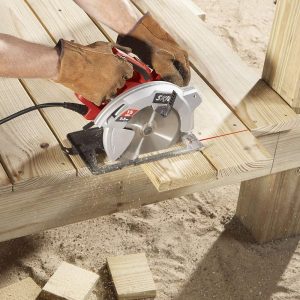
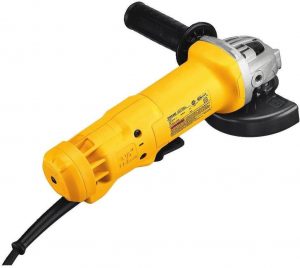
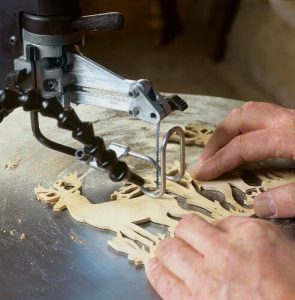
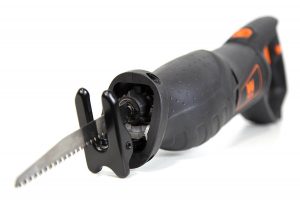
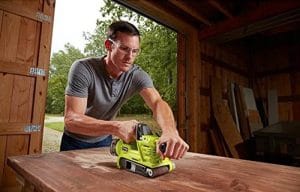

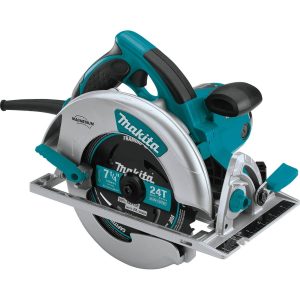 Makita 5007MG
Makita 5007MG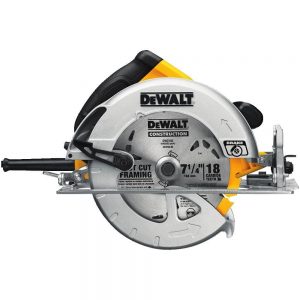 DeWalt DWE575SB
DeWalt DWE575SB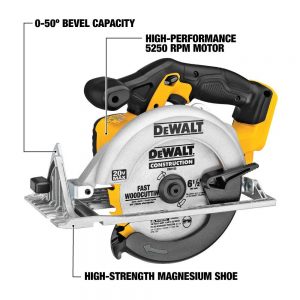 DeWalt DCS391B 20-Volt MAX
DeWalt DCS391B 20-Volt MAX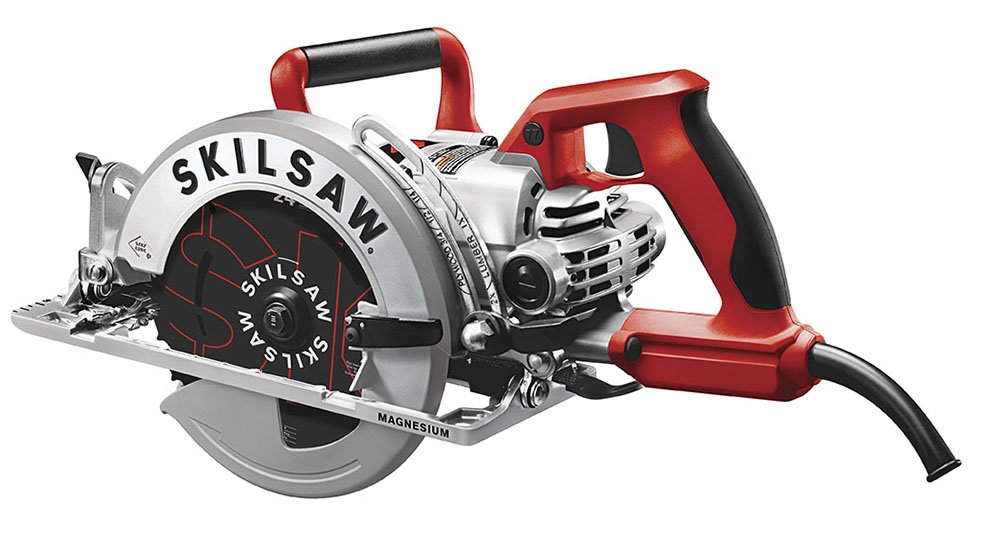
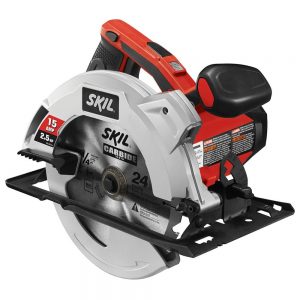 SKIL 5280-01
SKIL 5280-01